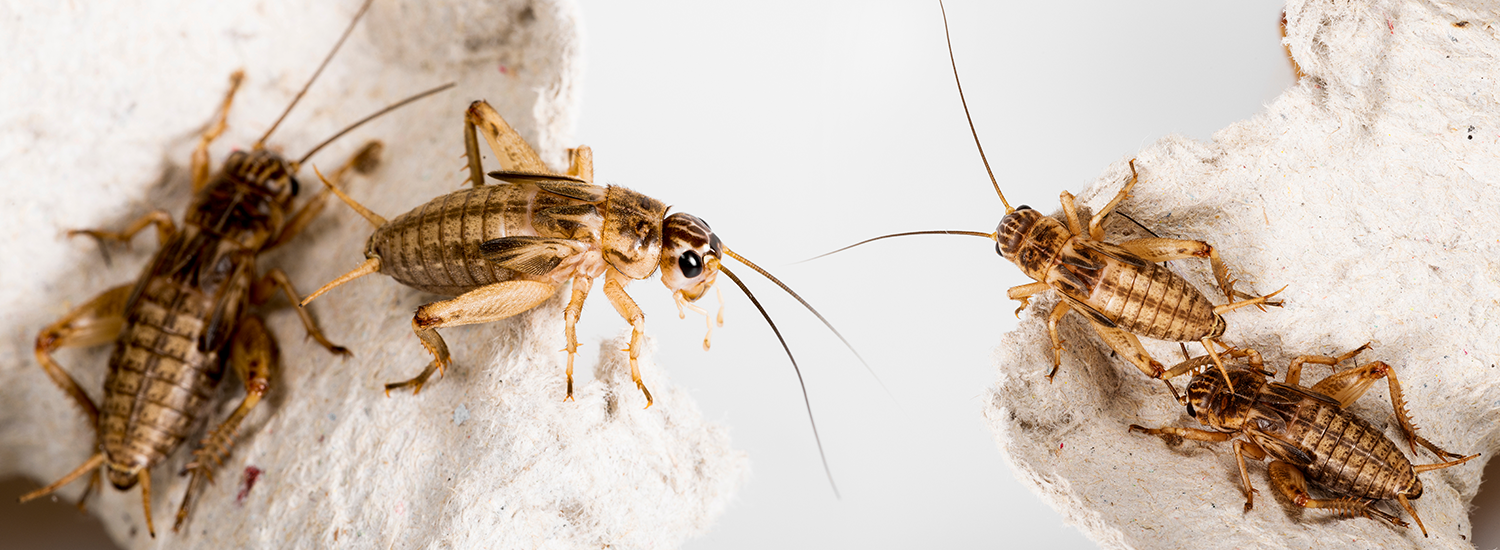What Do Crickets Look Like
- Size: Crickets are between 0.12 to 2 inches long.
- Color: Crickets vary in color but are typically light yellowish-brown with three dark crossbands on their head.
- Description: There are approximately 2,400 species of leaping insects that are found worldwide known for the chirping of the male.
- Lifespan: Crickets have an average lifespan of ninety days.
 General Description
General Description
Crickets are initially from Asia. They first entered the USA as pet food carried by pet and fishing stores. Crickets now live in the eastern portion of the country and parts of Southern California. These pests are raised as pet food in most states.
Crickets thrive in warm, moist environments. They gather near heater vents, kitchen stoves, and fireplaces. These pests come indoors for shelter and food. They also escape when homeowners buy them as pet food. Homeowners are particularly annoyed by crickets for their activity at night and loud chirping.
Outside, crickets eat plants and dead insects. They are likely found in pastures and fields. Inside they are found in pantries looking for fabric, pet food, fruit, and vegetables.
Male house crickets create two or three high-pitched sounds or chirping. They make these chirps by rubbing their wings together. As they are nocturnal, these pests are known to keep homeowners awake at night.
Reproduction
Male crickets chirp to find females for mating. Females lay more than 100 eggs in moist areas. The young hatch in the springtime. They require about two months to mature.
Damage
Crickets love to eat fabrics like silk, wool, cotton, and leather. They are particularly drawn to cloth stained with food or sweat. They can stain clothing and furniture with their waste.
Can Crickets Hurt You?
Crickets can bite. They don’t usually bite people. Nevertheless, you should get rid of crickets as soon as possible. The first sighting in your home is best. Cricket’s feces carry several diseases such as E.coli and salmonella. They are carriers of various species of worms. A cricket’s waste on your skin can cause skin sores. Eating food exposed to cricket feces can cause gastrointestinal distress, infection, and flu-like symptoms.
DIY Cricket Exterminator for your house and crickets in lawn
Good News! Moat Pest Control can get rid of that annoying chirping forever. After we have treated your home and your crickets in lawn, you keep them away for taking the following advice.
Diatomaceous Earth: For people and pets, diatomaceous earth is not toxic. For crickets, it will scratch their exoskeleton and kill them. Dematiaceous earth is an effective cricket exterminator to resolve crickets inside the home.
Use Cricket Traps: These are a real thing. They are glue traps. Keep this in mind. There is not any attractant in the trap. Catching crickets in cricket traps is by chance. The proper placement is critical for cricket pest control.
Use Your Vacuum: If you see the crickets, we recommend vacuuming them up. If one escapes while holding them for pet food, a homeowner should vacuum their home thoroughly.
Seal up openings: Sealing cracks will not get rid of crickets once you have them. It will keep their buddies from coming inside. Check to ensure that windows close tightly and screens don’t have tears. Doors need solid weather-stripping around the sides and a door and along the bottom. Utility lines can be sealed with caulking. They should be checked regularly to ensure the barrier has not broken down over time.
If you’ve tried to get rid of crickets and you’re still struggling, it’s time to call in Moat. We can get rid of the crickets—and their chirping—for good.

